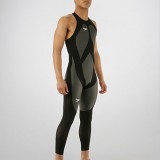 Updated on Jul 27, 2011 @ 03:23:
Updated on Jul 27, 2011 @ 03:23:
After three years since I posted this article, the subject suddenly sprang to life again. See this discussion in the forum: “Self-Bondage shop“. Have your own ideas or secret wishes? Dump them in the forum or here in the comments.
Published on: May 31, 2009 @ 01:18:
Technology and progress never stop. What was science fiction or fairy tales (many) years ago has become an integral part of our normal life. Even 15 years ago I could not even dream of a home computer with 4TB of storage space (95% full) and 12GB of real memory. (BTW, I need to vacuum clean it…).
What do we have in (self-)bondage and fetish fiction? Self-locking leotards and suits with built-in magnetic locks and moving gags and plugs, suits made out of special material which is able to bring the person to an almost immediate orgasm if that person makes any movement, zentai suits with no openings and zippers, just one tight super slippery inescapable membrane you can breath through, indestructible shiny transparent pantyhose correcting the form and shape of your legs, body-modification suits which make constant adjustment to the encased person, hermetic remote controllable suits with built-in tubes, pumps, pomps, plugs, gags, feeding tubes, locks etc…
How far is all of that from the real life?
Let’s have a look at the swimsuit technology and its future
About the creation of the Speedo LZR swimsuits:

To begin the research, the team attempted to identify the fabric with the least possible drag. They started by taking body scans of more than 400 elite swimmers to provide geometries for testing more than 100 different fabrics and suit designs. Work focused on developing two different fabrics: LZR Pulse®, an ultra-lightweight, powerful, lowdrag, water repellent, fast-drying fabric to be used as the base woven material for the suit; and LZR panels made of a low-drag, ultra-powerful polyurethane membrane to be bonded onto the base woven material to reduce drag at specific high-drag locations.
Speedo, the first manufacturer to use the compression core, which strengthens the midriff of the swimmers with less fatigue…
… the expensive suits … all feature new fabric incorporating plastics and compression technology.
About new nanotech clothing fabric (from NewScientist):

…the new self-cleaning fabric, made from polyester fibres coated with millions of tiny silicone filaments, is the most water-repellent clothing-appropriate material ever created. Drops of water stay as spherical balls on top of the fabric (see image, right) and a sheet of the material need only be tilted by 2 degrees from horizontal for them to roll off like marbles. A jet of water bounces off the fabric without leaving a trace.
This fine layer of air ensures that water never comes into contact with the polyester fabric. It can be submerged in water for two months and still remain dry to the touch.
The silicone nanofilaments also trap a layer of air between them, to create a permanent air layer. Similar layers – known as plastrons – are used by some insects and spiders to breathe underwater.
This is how swimsuits might evolve in the next 20 years according to The Future Laboratory (the entire report is here) :
The ‘transhumans’ are coming. We can’t expect gadget mania to stop at the handheld device so in the future, our bodies too will be temples to nano and bio technology, promising a future where swimming for several hours deep underwater without oxygen is as common as taking a long country walk.
Smart fabrics, especially electro fabrics, will be used so that electronic voltages will be passed across the material, compressing it in some places and not in others so the coach will be able to show the correct stroke action. This will then be recorded into the computer and then transmitted to the electro body suit. When the swimmer wearing the suit follows the same action as the coach, it will feel smooth; if the swimmer tries to deviate from the coach’s form, they will have to push against the material and it will be hard to do.
…digital goggles with feedback body suits is not so far away…
Developments in the field of nanotechnology will allow the human body to use artificial red blood cells that can store 200 times more oxygen and carbon dioxide than today’s natural red blood cells.
So, the technology is on the right track. But the fetish entertainment industry is years behind. Little interest? Too expensive? Too much ado when you can earn big bucks by photo-shooting-video-taping nude girls? No right people at the right place?
Will self-bondage remain a strictly DIY sport?
(due to a glitch in the DB, some images are displayed twice).

















As William Gibson says, “The furure is here. It’s just not evenly distributed”. There are materials that contract like a muscle when charged with a low voltage, adhesives that can lock fabric layers into one piece, magnetic locks, fabric that is gram for gram stronger than steel, silicon compounds that can stretch 8-10 times oricinal size without losing strength.
We just need a few bright and perverted engineers…
Very true. “Perverted engineers” backed up by money and infrastructure.
On the other hand, the “perverted companies” are also there. For example, SimonO, Demask, House of Harlot, PESelectro, Fetters, etc. Every company of that scale should have its own Research & Development department. Unfortunately, they do not come up with new products so often, And I can’t call their new lines “innovative”. Mostly new clothes design. Or new colours.
There are so many possibilities out there. But it seems like nobody is interested. Either no demand, or too risky for investing, or like you said no bright and perverted engineers.
Even Japan’s “ultimateness” and “perfect absurdness” (absurd perfectness?) seem to have no new ideas.
Erotic industry stagnation? Or it’s just what we discussed not so long ago (Kova & T) – can’t find anything? don’t like what’s available? Create your own design and your own company.
In the fetish field that reminds me Billy from The Modulus Fashion Lab . He designed his own computer models of skinsuits with as less seams as possible, but since there were no mass production and mass demand, the prices were/are (understandably) astronomical. The result? The other companies copied his design, lowered both price and quality, dropped off what’s not or not gonna be very popular and added to their production line.
What happened next? Chinese manufactures bought a couple of suits from that second iteration, reverse engineered, simplified, discounted, stole the original photos and are selling the suits on eBay for ~10-20$.
Interesting fact. Even with assistance it takes 20 (twenty!) minutes to put on the full Speedo LZR swimsuit. Twenty minutes! About the same time I get inside my undersized latex suits generously lubricated with J-Lube.
I have to agree: The lack of fetish innovation is curious and frustrating. There are a few constraining problems for people who want to innovate. First, the fetish community is enormous, but wildly diverse. Perhaps that diversity makes it hard to find an adequate customer base for a new innovation.
Second, “normal” society tacitly ignores the fact that many people find pleasure and excitement in exploring different sexual practices. so, protecting intellectual property is difficult. As you mentioned, Modulus Labs had their best ideas stolen. Modulus has little recourse.
Also, becuse fetish is not mainstream, sales and marketing channels are hard to establish. Butt plugs and latex suits just don’t show up in Vogue or the Times…
Still, there is some real innovation. Example: your aquarium pumps and timers set up and ice locks. Njoy is another interesting example. They have raised butt plugs to a new level.
We’ll just have to keep experimenting. I’d really like to get a batch of that material that contracts with low voltage… 😉
I think the future of self bondage would have something to do with computers. It could be something as simple as computerized locks of cuffs. Imaging putting the locks on with a setting for 2 hours.
great post ra, i sort of agree, but reluctantly, i wish all our fantasies could come true, but alas money is always there to stop us
If virtual reality tech advances far enough, you’ll be able to come up with whatever’s in your wildest dreams.
The “Matrix”-like virtual reality would solve lots of different problems. If you have a brain-coupled data-port, you need neither TV, nor audio-system, and you can play any game or movie character “in real”. And (if programmed) the wildest dreams could indeed come true.
On the other hand, certain hardware or software bugs can easily be lethal.
While this is not (yet) feasible, some (who can draw) draw, some play Second Life and some continue to invent weird devices. See, for example, this thread.
Self-bondage fetish wear is alive and well using existing materials and some imagination!
For me, at least.
Latex, latex and more latex, j-lube and sex toys locked and concealed under street clothes can pretty much pretty much rock my world.